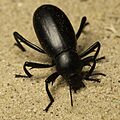Desert stink beetle facts for kids
Quick facts for kids Desert stink beetle |
|
|---|---|
 |
|
| Eleodes armata | |
| Scientific classification |
|
| Kingdom: | Animalia |
| Phylum: | Arthropoda |
| Class: | Insecta |
| Order: | Coleoptera |
| Family: | Tenebrionidae |
| Tribe: | Amphidorini |
| Genus: | Eleodes Eschscholtz, 1829 |
| Type species | |
| Eleodes dentipes Eschscholtz, 1829
|
|
| Subgenera | |
|
See text |
|
 |
|
| Map of North America with the range of Eleodes highlighted in dark grey. | |
Eleodes beetles, often called pinacate beetles or desert stink beetles, are a type of darkling beetles. They belong to the family Tenebrionidae. These beetles live mostly in western North America. You can find them from southern Canada all the way to Mexico. Many species live in the Sonoran Desert and Southern California. Some have even been found in Colombia, where they were brought in by humans. The name pinacate comes from Mexican Spanish. It means "black beetle" in the ancient Nahuatl (Aztec) language.
Eleodes beetles come in different sizes, from about 10 to 50 millimeters long. That's about half an inch to two inches! They are usually black. Some even have a reddish color on their belly. A few species, like Eleodes osculans, have tiny hairs called setae. These hairs can collect dirt, making the beetle look brown. Another species, Eleodes mirabilis, looks like it has white stripes because of this. Because there are so many types and they live in a large area, these beetles look quite different from one another. All Eleodes beetles make a stinky liquid to scare off animals that want to eat them. Many will even stand on their heads to spray this liquid! They mostly live in dry desert areas. But you can also find them in forests and grasslands. All Eleodes beetles cannot fly. Their wing covers, called elytra, are stuck together. Their second pair of wings is very small and not used for flying.
Contents
How Pinacate Beetles Live
Most Eleodes beetles are detritivores. This means they eat dead plants and animals. Some species, especially those from the plains of North America, prefer to eat living plants. Examples include Eleodes hispilabris and Eleodes opaca. The young beetles, called larvae, of these species can sometimes be a problem. They are considered pests because they eat the roots of crops.
Beetles living in dry places, like those in the subgenus Eleodes, are often larger than most insects. This is because they need bigger bodies to store more water in the desert. Losing water is also why their wing covers are fused together. Beetles found in forests, such as those in the subgenus Blapylis, are smaller. They are closer to the size of most other insects.
Eleodes beetles are usually more active at night. Some species are only nocturnal. Others can be active during the day too. These beetles live for a fairly long time for insects. So, they must change their habits with the seasons. In fall and winter, they are more active during the day. This helps them avoid freezing at night. When summer comes, they are much more active at night. The desert sun can be very hot and dangerous during the day. One special group, Caverneleodes, lives only in caves or rocky cracks. These beetles have small eyes. They only come out at night to find food.
Stinky Defense
Eleodes beetles, and other darkling beetles, have a special way to protect themselves. They release a bad-smelling liquid from glands. This liquid tastes very bad to predators. It is usually a chemical called quinone. This liquid is not poisonous, but it does scare away most animals. This successful defense has led to something cool called Müllerian mimicry. This is when different species that are all bad-tasting look alike. For example, Eleodes acuticauda, Eleodes dentipes, and Coelocnemis magna all look very similar. Coelocnemis magna is not an Eleodes beetle, but it also tastes bad. By looking alike, they all get stronger protection from predators. Another example of this mimicry is between Eleodes scabrosa and Eleodes tuberculata.
Even with their stinky defense, many animals still eat these beetles. These predators include owls, foxes, coyotes, skunks, bats, and turtles.
History and How They Changed Over Time
Scientists have found fossils of Eleodes beetles in places like the La Brea Tar Pits. These fossils include species like Eleodes acuticauda, Eleodes osculans, and Eleodes carbonaria. These fossil sites date back to the Pleistocene epoch, which was a long time ago! It is thought that Eleodes beetles first appeared even earlier. They probably evolved in the late Miocene or Pliocene periods.
How They Might Have Evolved
One idea is that the subgenus Blapylis is the oldest group within Eleodes. This is because they look like other beetles that are not Eleodes but are related. So, the first Eleodes beetles might have looked more like Blapylis beetles. It's thought that Eleodes beetles might have evolved before the Ice Ages began. Back then, western North America was covered in huge forests. As the ice ages started, plains and deserts slowly grew across the western part of the continent. Some Eleodes beetles might have changed to fit these new, drier areas. These beetles would have become larger to hold more water. They then formed new groups within Eleodes, making the genus what it is today.
Naming and Groups
Eleodes is the largest group of darkling beetles in the New World. There are about 200 different species! These species are divided into 16 main groups called subgenera.
- Subgenus Amphidora
- Subgenus Blapylis
- Subgenus Caverneleodes
- Subgenus Chaseleodes
- Subgenus Cratidus
- Subgenus Discogenia
- Subgenus Eleodes
- Subgenus Heteropromus
- Subgenus Litheleodes
- Subgenus Melaneleodes
- Subgenus Metablapylis
- Subgenus Omegeleodes
- Subgenus Promus
- Subgenus Pseudeleodes
- Subgenus Steneleodes
- Subgenus Tricheleodes
Images for kids
See also
 In Spanish: Eleodes para niños
In Spanish: Eleodes para niños



